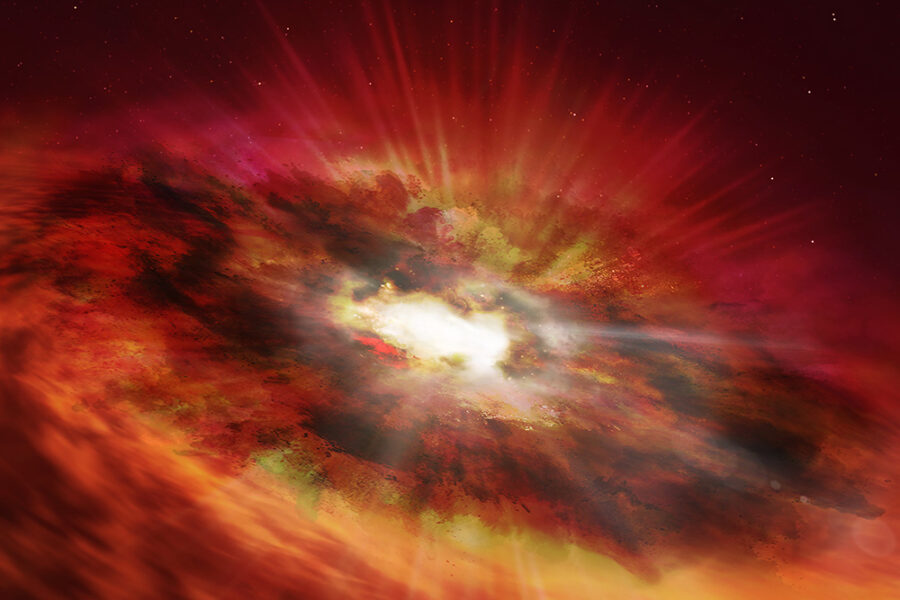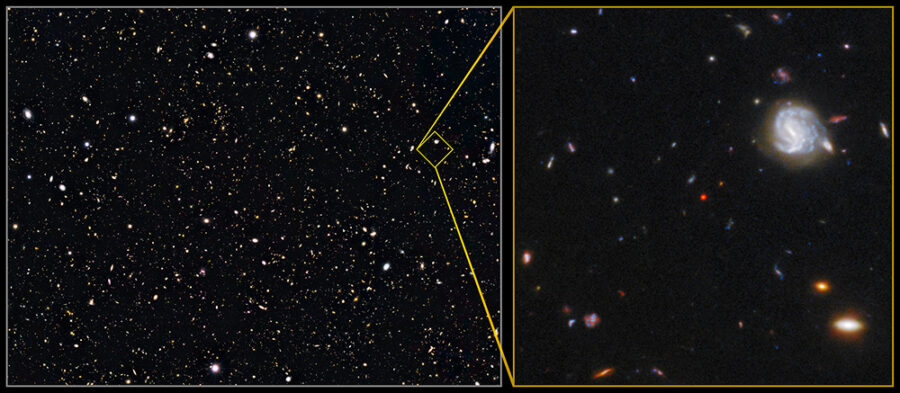A distant object in a deep Hubble Space Telescope field could be in transition from ordinary galaxy to brilliant beacon of light.

NASA / ESA / N. Bartmann
Astronomers have discovered a precursor to quasars, the brilliant beacons powered by gas-guzzling black holes with masses equivalent to millions or even billions of Suns. The find sheds light on the mystery of how quasars grow so quickly.
Deep observations have shown that quasars exist full-grown less than 1 billion years after the Big Bang. Looking back through space and time to find these objects is like finding mountains grown tall where there was flat ground the day before.
To find out how quasars grow so massive so quickly, astronomers want to find quasars before they outshine their host galaxies with their brilliance. But finding the “before” pics can be difficult, in part because of how quasars are thought to grow.
The plot goes something like this: Two just-formed galaxies in the early universe meet. Each of them may host an already-massive central black hole already. (How the black holes get there to begin with is another story.) Upon colliding, the galaxies’ black holes coalesce into a single, more massive one; gases redirected to the center add even more mass to this newborn behemoth.
One of the best ways to know if a supermassive black hole is feeding is by the X-rays emitted from the material closest to the maw. But the galactic smash-up also triggers intense star formation, lighting up the host galaxy while shrouding the center in dust — and hiding those X-rays from view. Only when the black hole has powered winds and/or a jet that extinguish the galaxy’s star formation can the quasar at its center truly shine.
Such quasar precursors (known in technical terms as Compton-thick active galactic nuclei) have been found before in the relatively nearby universe. But if quasars exist within the universe’s first billion years, then the precursors should, too.

Science: NASA / ESA / Garth Illingworth (UC Santa Cruz) / Pascal Oesch (UC Santa Cruz, Yale) / Rychard Bouwens (LEI) / I. Labbe (LEI) / Cosmic Dawn Center / Niels Bohr Institute / Univ. of Copenhagen, Denmark
While reprocessing data from a deep Hubble Space Telescope image known as the Great Observatories Origins Deep Survey (GOODS)-North, Seiji Fujimoto (Cosmic Dawn Center, Denmark) and colleagues have found just such an early quasar forerunner, reporting the results in Nature.
Dubbed GNz7q, the galaxy existed just 700 million years after the Big Bang and it’s undergoing a tremendous starburst, birthing some 1,600 Suns’ worth of stars every year. (The Milky Way Galaxy, for reference, makes just a couple Suns’ worth of stars per year.) An emission line associated with this star formation confirms the galaxy’s extreme distance from Earth.
GNz7q’s observed brightness at infrared wavelength shows a pattern similar to nearer quasars, but reddened by dust in the same way that dust in the air reddens sunsets. Chandra X-ray Observatory images of the same field show that the galaxy emits very little or no X-rays, another indication that dust is shrouding activity in the galactic center.
If there’s an active supermassive black hole inside this galaxy, then it’s a doozy: Some 10 million times the Sun’s mass and feeding at a rate so extreme that it will soon be belching out the gas at a rate higher than what comes in.
There’s a chance that, rather than a gas-guzzling black hole, there’s instead a core of intense star formation. Fujimoto and colleagues argue that's unlikely because the ultraviolet light would have to come from such a compact source that it would require extreme amounts of star formation, upwards of 5,000 Suns’ worth a year.
However, Ryan Hickox (Dartmouth College), who was not involved in the study, points out that it’s a real possibility. “There are galaxies in the more nearby universe for which star formation is known to be almost (if not quite) as compact as observed here,” he notes. “So the alternative possibility, as the paper suggests, that this could be extremely highly compact star formation that would be unique to the early universe is definitely plausible.”
Ultimately, more observations will help nail down what this distant galaxy holds, whether it be a dust-shrouded supermassive black hole or an intense star factory. “Either way,” Hickox says, “it is a very interesting object!”
 0
0









Comments
You must be logged in to post a comment.